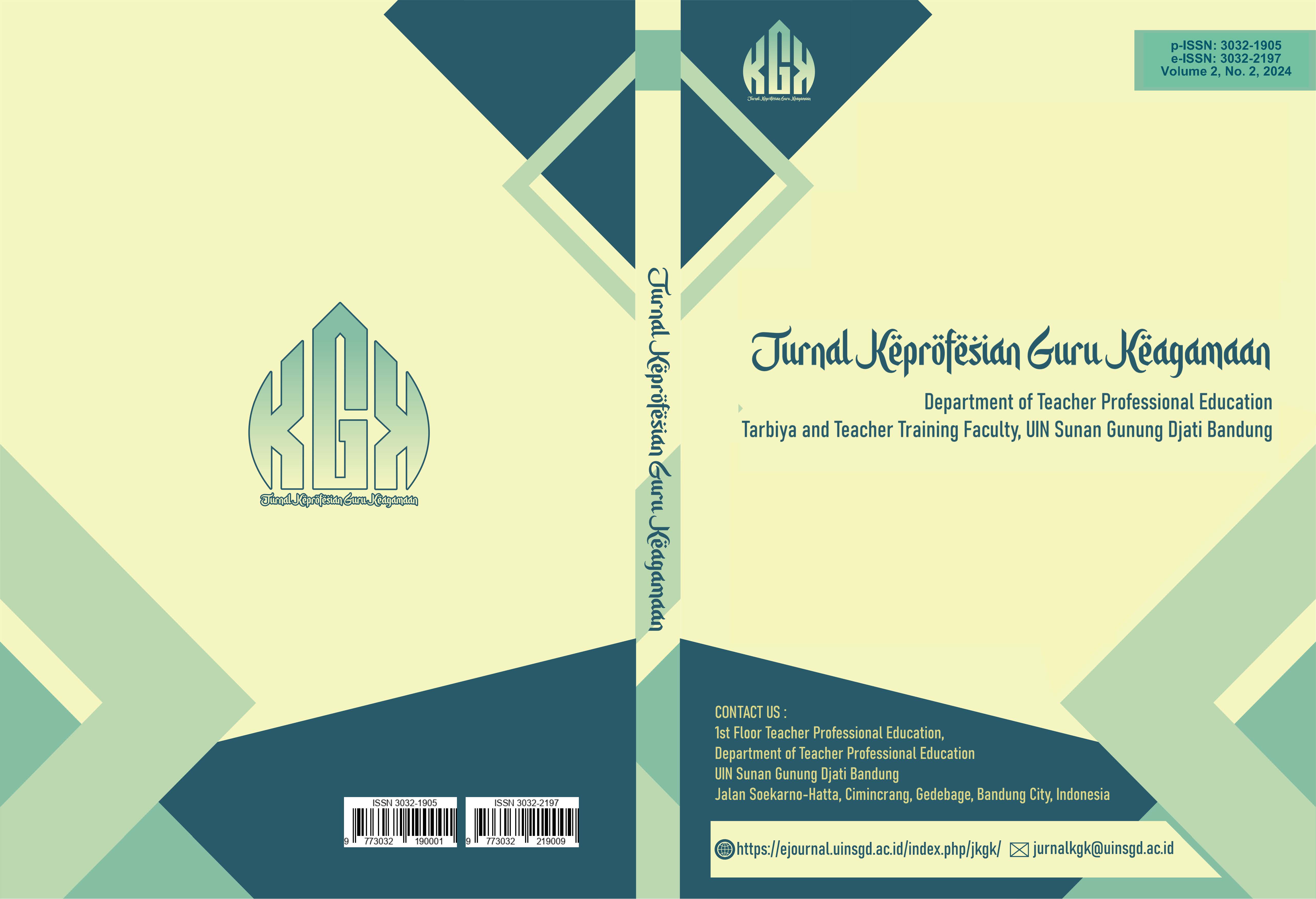Applying True or False Method to Improve Learning on Faith in Elementary Students
DOI:
https://doi.org/10.15575/jkgk.v2i2.983Keywords:
Faith in Qadha and Qadar, Learning Outcomes, True or False Learning ModelAbstract
The success of learning is greatly influenced by a teacher's ability to design effective teaching strategies. Low student enthusiasm has a negative impact on learning outcomes, highlighting the need for improvement. One proposed approach is the True or False learning model, which can enhance student engagement. This study aims to improve students' learning outcomes on the topic of faith in qadha and qadar in class VI at MIN 2 Aceh Timur through the application of this model. The method used is action research with two cycles, each consisting of four stages: planning, action and observation, reflection, and revision. The target of the research is class VI students, with data collected from formative tests and observation sheets. The analysis results indicate a significant improvement in student learning outcomes. The mastery level in cycle I reached 74.10%, increasing to 85.19% in cycle II. The average student score also rose from 75 in cycle I to 82.8 in cycle II. Additionally, student activity increased from 66.67% in cycle I to 96.3% in cycle II. Therefore, the True or False model is effective in enhancing students' learning outcomes and engagement in Akidah Akhlak lessons.
References
Ferri, F., Grifoni, P., & Guzzo, T. (2020). Online learning and emergency remote teaching: Opportunities and challenges in emergency situations. Societies, 10(4), 86. https://doi.org/https://doi.org/10.3390/soc10040086
Geels, F. W. (2020). Micro-foundations of the multi-level perspective on socio-technical transitions: Developing a multi-dimensional model of agency through crossovers between social constructivism, evolutionary economics and neo-institutional theory. Technological Forecasting and Social Change, 152, 119894. https://doi.org/https://doi.org/10.1016/j.techfore.2019.119894
Gillies, R. M. (2019). Promoting academically productive student dialogue during collaborative learning. International Journal of Educational Research, 97, 200–209. https://doi.org/https://doi.org/10.1016/j.ijer.2017.07.014
Holmes, K., & Prieto-Rodriguez, E. (2018). Student and staff perceptions of a learning management system for blended learning in teacher education. Australian Journal of Teacher Education (Online), 43(3), 21–34.
Kumarassamy, J., & Koh, C. (2019). Teachers’ perceptions of infusion of values in science lessons: a qualitative study. Research in Science Education, 49(1), 109–136. https://doi.org/https://doi.org/10.1007/s11165-017-9612-8
Morris, T. H. (2019). Self-directed learning: A fundamental competence in a rapidly changing world. International Review of Education, 65(4), 633–653. https://doi.org/https://doi.org/10.1007/s11159-019-09793-2
Munna, A. S., & Kalam, M. A. (2021). Teaching and learning process to enhance teaching effectiveness: a literature review. International Journal of Humanities and Innovation (IJHI), 4(1), 1–4. https://doi.org/https://doi.org/10.33750/ijhi.v4i1.102
Nurtanto, M., Fawaid, M., & Sofyan, H. (2020). Problem based learning (PBL) in Industry 4.0: Improving learning quality through character-based literacy learning and life career skill (LL-LCS). Journal of Physics: Conference Series, 1573(1), 012006. https://doi.org/10.1088/1742-6596/1573/1/012006
Putra, R. M., Solekhah, S., Agustina, D. D., & Sobirov, B. (2021). Action Learning Strategy to Enhance Students Speaking Skill: A Classroom Action Research. Anglophile Journal, 2(1), 37–54. https://doi.org/https://doi.org/10.51278/anglophile.v2i1.269
Retnawati, H., Djidu, H., Kartianom, K., Apino, E., & Anazifa, R. D. (2019). Teachers’ Knowledge about Higher-Order Thinking Skills and Its Learning Strategy. Problems of Education in the 21st Century, 76(2), 215–230.
Ryan, R. M., & Deci, E. L. (2020). ntrinsic and extrinsic motivation from a self-determination theory perspective: Definitions, theory, practices, and future directions. Contemporary Educational Psychology, 61, 101860. https://doi.org/https://doi.org/10.1016/j.cedpsych.2020.101860
Shearer, R. L., Aldemir, T., Hitchcock, J., Resig, J., Driver, J., & Kohler, M. (2020). What Students Want: A Vision of a Future Online Learning Experience Grounded in Distance Education Theory. American Journal of Distance Education, 34(1), 36–52. https://doi.org/https://doi.org/10.1080/08923647.2019.1706019
Sun, Y., & Gao, F. (2019). Exploring the roles of school leaders and teachers in a school-wide adoption of flipped classroom: School dynamics and institutional cultures. British Journal of Educational Technology, 50(3), 1241–1259. https://doi.org/https://doi.org/10.1111/bjet.12769
Tharayil, S., Borrego, M., Prince, M., Nguyen, K. A., Shekhar, P., Finelli, C. J., & Waters, C. (2018). Strategies to mitigate student resistance to active learning. International Journal of STEM Education, 5(7), 1–16. https://doi.org/https://doi.org/10.1186/s40594-018-0102-y
Wibowo, S., Wangi, M. N., & Firdaus, F. M. (2025). The relevance of Vygotsky’s constructivism learning theory with the differentiated learning primary schools. Journal of Education and Learning (EduLearn), 19(1), 431–440. https://doi.org/https://doi.org/10.11591/edulearn.v19i1.21197
Downloads
Published
How to Cite
Issue
Section
License
Copyright (c) 2024 Authors

This work is licensed under a Creative Commons Attribution-ShareAlike 4.0 International License.




